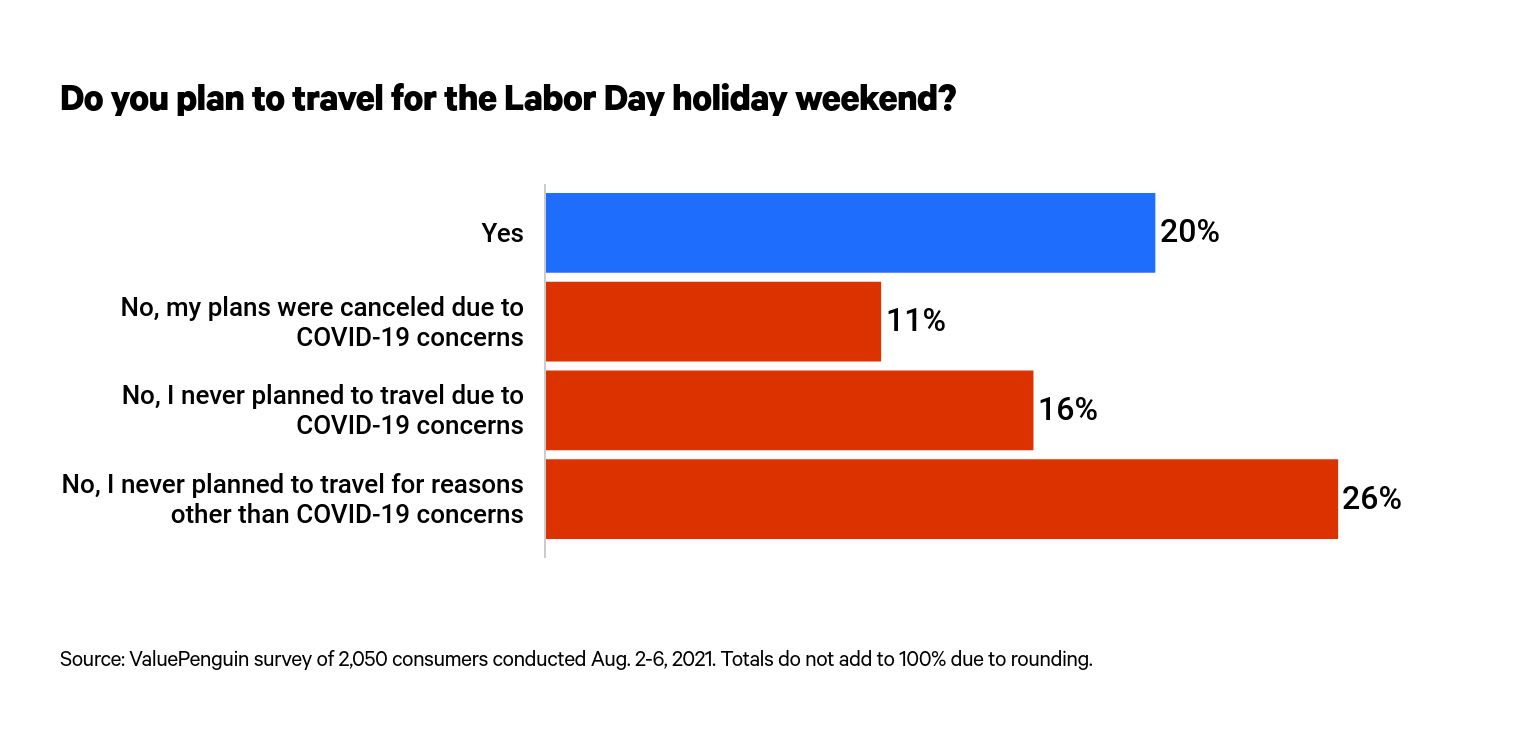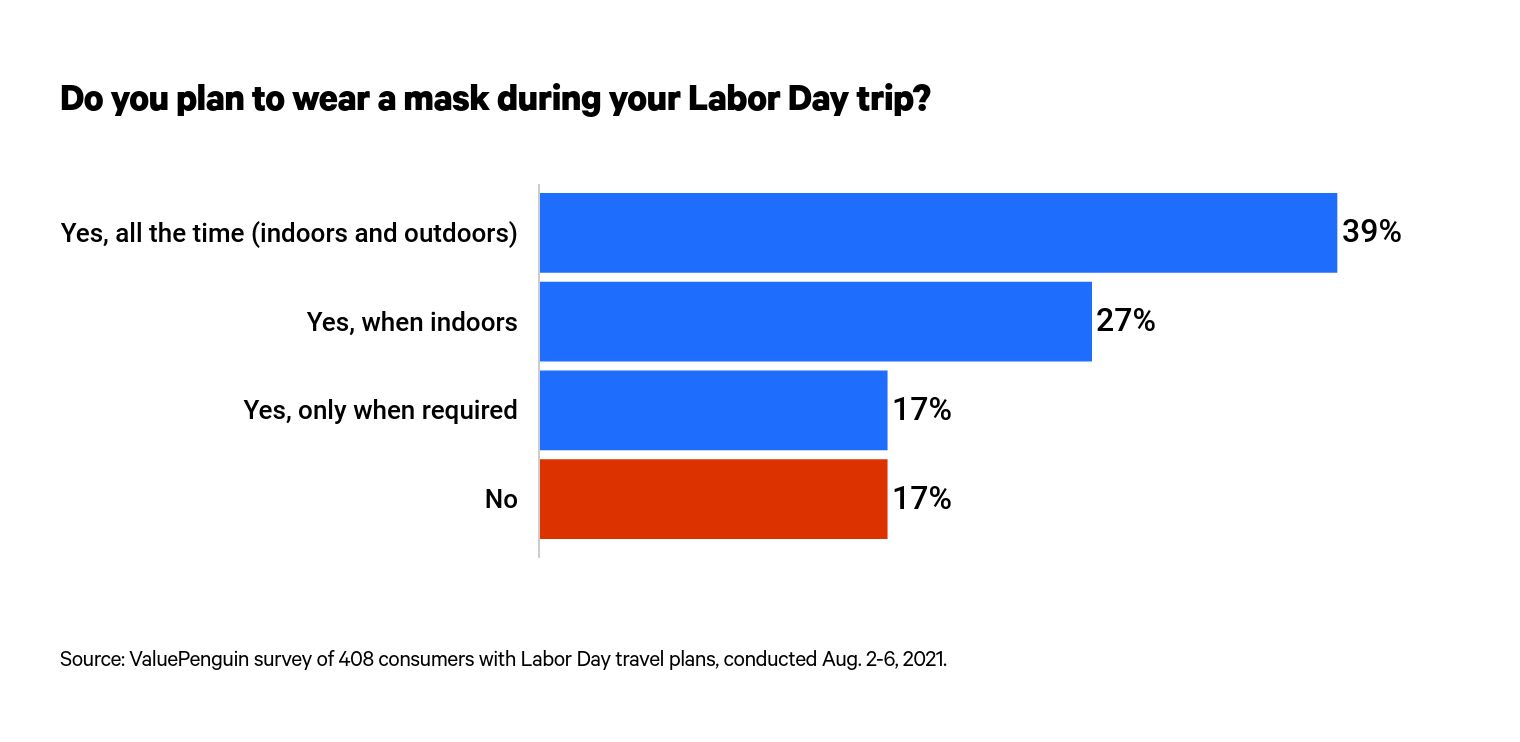Travel
51 Million Americans Have Labor Day Travel Plans, With Florida the Top Destination
Editorial Note: The content of this article is based on the author’s opinions and recommendations alone. It may not have been reviewed, approved or otherwise endorsed by the credit card issuer. This site may be compensated through a credit card issuer partnership.
Terms apply to American Express benefits and offers. Visit americanexpress.com to learn more. Citi is an advertising partner.

Despite the delta variant, 1 in 5 Americans say they have plans to travel for Labor Day weekend, though 11% said they’ve canceled their trips as cases continue to rise — that’s according to a ValuePenguin survey of more than 2,000 consumers. Car trips are the most popular transportation option, while Florida is the top destination of choice. Find out more about what the last holiday weekend of summer has in store.
Key findings
- One in 5 (20%) of Americans — 51 million — are traveling for Labor Day. Those most likely to travel include six-figure earners (32%), parents with kids under 18 (30%) and Gen Xers (25%).
- But 29 million (11%) have had to cancel plans (or had them canceled) due to delta variant concerns.
- Florida is the top Labor Day travel destination among those heading out-of-state. About 4 in 10 travelers (38%) are going to another state, with 12% traveling to Florida. California and New York are the next top vacation spots (both tied at 8%).
- Hotels and resorts are the most popular lodging choice among Labor Day travelers (44% will stay at one), beating out vacation rentals and staying with friends or family. As for how they’ll get there, most (70%) will drive while 23% will fly.
- Less than 40% of Labor Day travelers plan to mask up both indoors and outdoors during their trip. Instead, 27% will only wear a mask while indoors, 17% when required (such as on a plane) and 17% won’t wear one at all.
- Because you never know… 57% of Labor Day travelers insured their trip. That includes 38% who purchased a travel insurance policy, and 19% who get travel insurance via their credit card.
Labor Day travel: Some canceled amid coronavirus concerns, others moving forward as planned
More than 1 in 10 (11%) of would-be Labor Day vacationers have had to nix their plans due to rising concerns about the delta variant. That figure includes both those who canceled their trips on their own, as well as others who may have had a travel provider cancel their itinerary or flight.
"While 11% seems like a relatively low number, I fear that number may climb as Labor Day approaches," says Sophia Mendel, travel writer at ValuePenguin.
If Delta keeps gaining traction, she warns, the potential of a last-minute cancellation goes up.
In the meantime, around 51 million Americans (or 20%) say their travel plans are still on. The most likely groups to have a planned Labor Day trip include six-figure earners (32%), parents with kids under 18 (30%) and Gen Xers (25%) — more so than their counterparts.

Florida is the top destination for out-of-state travelers
The majority of Labor Day travelers (56%) are limiting travel to within their home state, while 38% are crossing state lines.
For those venturing beyond state borders, the top destinations are:
- Florida (12%)
- California (8%)
- New York (8%)
Though Florida is always a popular summer destination because of its beaches and attractions, it might come as a surprise that it leads this year given the coronavirus surge that’s happening right now.
"I think it’s likely people are choosing to travel to Florida right now because the COVID-19 rules are notoriously relaxed," says Mendel. "A state with lax COVID-19 restrictions is a bonus for those who want to make sure their travel plans don’t get canceled, even at the risk of possibly contracting and spreading COVID-19."
The vast majority (70%) are opting to travel in their own vehicles, but for the 23% who have booked airline tickets, it’s important to plan ahead. "Particularly with recent flight cancellations and unruly passenger behavior, you’ll want to plan your trip with some amount of flexibility. Show up early at the airport, and prepare for delays and long lines," says Mendel.
Most travelers have chosen to stay at a hotel or resort (44%), while 38% are staying with family or friends. About 1 in 10 booked a vacation rental like Airbnb.

Not everyone will mask up during their vacation
Just about 40% of travelers say they’ll wear their masks both indoors and outdoors; another 27% say they’ll only cover up indoors. That leaves the rest who say they will only don a mask when required (17%), or not at all (17%).
Gen X and baby boomers (24% and 23% respectively) were more likely to say they won’t be masking up at all as compared to younger generations — millennials (13%) and Gen Z (11%) — who said the same. Notably, the most recent CDC guidelines recommend wearing a mask indoors, even for those who are vaccinated.

More than half of travelers insured their Labor Day trip
Insuring your Labor Day trip with travel insurance is a great move, especially in the wake of rising delta variant cases, says Mendel. For the 57% of Americans who did just that (with either a separate policy or via their credit cards), they’re protected should they encounter a last-minute cancellation. "Worst case scenario, if your trip gets canceled, you’ll at least get your money back or have credit to use on a future trip," says Mendel.
As for how travelers are funding their trip, non-rewards credit cards were the most popular choice (43%), followed by 24% who said they used a travel rewards or airline card.
"I can’t recommend using a travel rewards card more to plan your future travel. You earn points simply by using your credit card, and then are rewarded by being able to book a free flight or hotel room," says Mendel. Some cards also offer additional perks like getting a free checked bag and priority boarding at the airport, or free nights or room upgrades at hotels. In fact, Mendel says her travel rewards cards fund all of her trips: "I never have to pay out of pocket."

Just a little over half of consumers have planned a budget-friendly Labor Day getaway of less than $500. Here’s how it breaks down:
- Less than $100: 15%
- $100 to $499: 36%
- $500 to $999: 25%
- $1,000 to $1,999: 12%
- $2,000 or more: 13%
The demographics most likely to spend big ($2,000 or more) are Gen Z (19%), parents with kids under 18 (15%) and those earning more than $100,000 (24%).
Labor Day travel tips
If you’ve already made Labor Day travel plans or are considering a last-minute getaway, here are some tips to pack with you:
- Know the rules in your destination of choice. "With vaccine passports getting rolled out in some states, it’s important to know what will be available to you upon arrival given your personal vaccination status," says Mendel. For instance, in big cities like New York City and San Francisco, you must bring along proof of vaccination to dine indoors, see a show, or visit a museum.
-
Practice patience. Lines and wait times may be longer than usual given the countrywide labor shortage, says Mendel. "Be sure to plan way ahead when it comes to restaurant reservations, tickets to events and attractions and car rentals," says Mendel.
-
Cash in your rewards. If you still haven’t booked any Labor Day travel, tap into credit card miles and points you may have. "Use your travel rewards credit card to save money on a last-minute flight and ensure you’re still able to take a trip and celebrate the last days of summer," says Mendel.
Methodology
ValuePenguin commissioned Qualtrics to conduct an online survey of 2,050 U.S. consumers from Aug. 2 to Aug. 6, 2021. The survey was administered using a nonprobability-based sample, and quotas were used to ensure the sample base represented the overall population. All responses were reviewed by researchers for quality control.
We defined generations as the following ages in 2021:
- Generation Z: 18 to 24
- Millennial: 25 to 40
- Generation X: 41 to 55
- Baby boomer: 56 to 75
While the survey also included consumers from the silent generation (defined as those 76 and older), the sample size was too small to include findings related to that group in the generational breakdowns.
